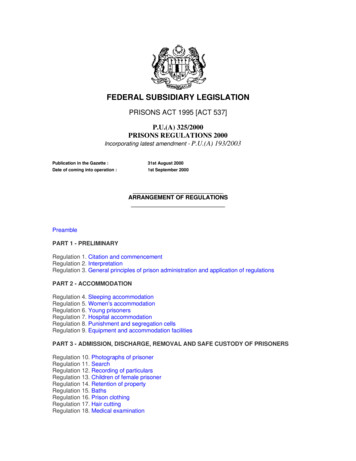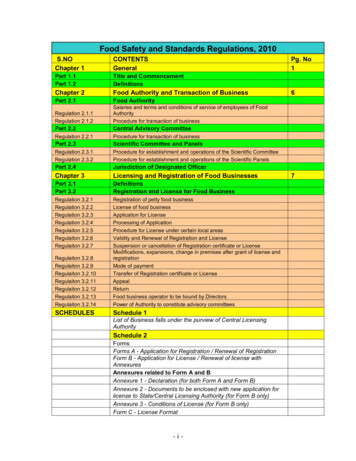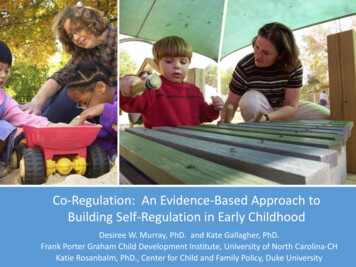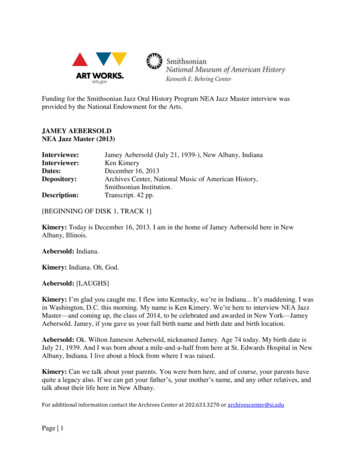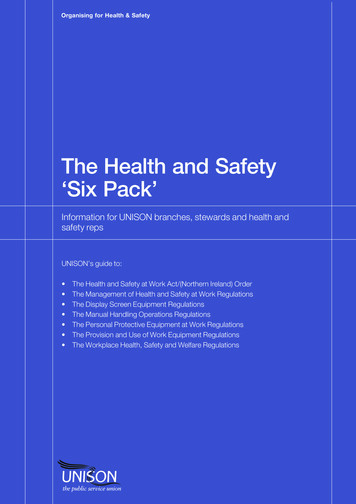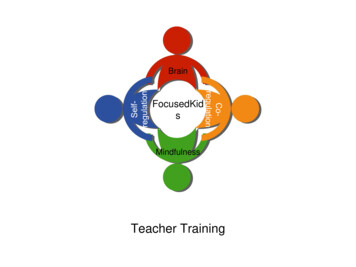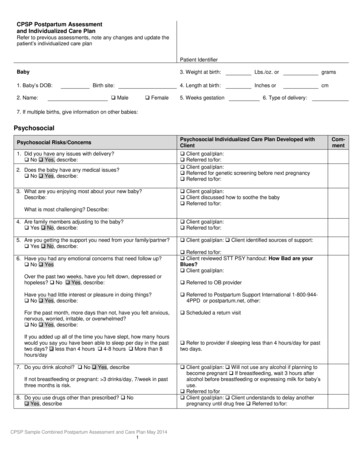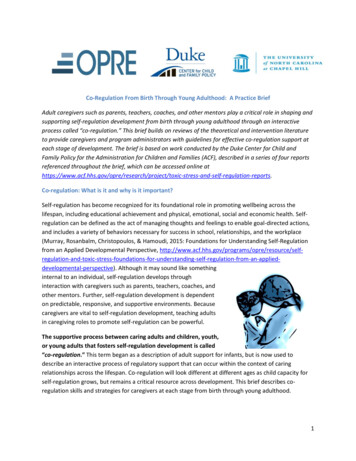
Transcription
Co-Regulation From Birth Through Young Adulthood: A Practice BriefAdult caregivers such as parents, teachers, coaches, and other mentors play a critical role in shaping andsupporting self-regulation development from birth through young adulthood through an interactiveprocess called “co-regulation.” This brief builds on reviews of the theoretical and intervention literatureto provide caregivers and program administrators with guidelines for effective co-regulation support ateach stage of development. The brief is based on work conducted by the Duke Center for Child andFamily Policy for the Administration for Children and Families (ACF), described in a series of four reportsreferenced throughout the brief, which can be accessed online on: What is it and why is it important?Self-regulation has become recognized for its foundational role in promoting wellbeing across thelifespan, including educational achievement and physical, emotional, social and economic health. Selfregulation can be defined as the act of managing thoughts and feelings to enable goal-directed actions,and includes a variety of behaviors necessary for success in school, relationships, and the workplace(Murray, Rosanbalm, Christopoulos, & Hamoudi, 2015: Foundations for Understanding Self-Regulationfrom an Applied Developmental Perspective, al-perspective). Although it may sound like somethinginternal to an individual, self-regulation develops throughinteraction with caregivers such as parents, teachers, coaches, andother mentors. Further, self-regulation development is dependenton predictable, responsive, and supportive environments. Becausecaregivers are vital to self-regulation development, teaching adultsin caregiving roles to promote self-regulation can be powerful.The supportive process between caring adults and children, youth,or young adults that fosters self-regulation development is called“co-regulation.” This term began as a description of adult support for infants, but is now used todescribe an interactive process of regulatory support that can occur within the context of caringrelationships across the lifespan. Co-regulation will look different at different ages as child capacity forself-regulation grows, but remains a critical resource across development. This brief describes coregulation skills and strategies for caregivers at each stage from birth through young adulthood.1
What caregiver behaviors contribute to co-regulation?In this brief, the term “caregiver” is used to describe any adult who provides care and support to a child,youth, or young adult. This includes but is not limited to parents, guardians, teachers, child careproviders, coaches, youth group leaders, and other mentors. Regardless of their role, a caregiver’swarmth, responsiveness, and sensitivity support self-regulation development and may buffer the effectsof adverse childhood experiences. Effective co-regulation by a supportive caregiver will promote selfefficacy and allow children, youth, and young adults to feel secure enough to practice new skills andlearn from mistakes.There are three broad categories of support that caregivers can provide to children, youth, and youngadults that will help them to develop foundational self-regulatory skills and expand these skills to meetincreasingly complex regulatory needs as they grow (Murray et al., 2015): Provide a warm, responsive relationship bydisplaying care and affection; recognizing andresponding to cues that signal needs and wants; andproviding caring support in times of stress.Caregivers can build strong relationships withchildren, youth, and young adults by communicating,through words and actions, their interest in theyoung person’s world, respect for the young personas an individual, and commitment to caring for theyoung person no matter what (i.e., unconditionalpositive regard).Structure the environment to make self-regulationmanageable, providing a buffer againstenvironmental stressors. This means creating anenvironment that is physically and emotionally safe for children, youth, and young adults toexplore and learn at their level of development without serious risk to their wellbeing.Consistent, predictable routines and expectations likewise promote a sense of security byproviding clear goals for behavior regulation, in addition to well-defined logical consequencesfor negative behaviors.Teach and coach self-regulation skills through modeling, instruction, opportunities for practice,prompts for skill enactment, and reinforcement of each step towards successful use of skills.Like a coach on a sports team, caregivers should first teach skills, and then provide neededsupports, or scaffolding, for self-regulation enactment in the moment.What about caregiver self-regulation?The first thing for caregivers such as parents, teachers, coaches, and other mentors to focus on is theirown capacity for self-regulation. To co-regulate successfully, caregivers will need to:2
Pay attention to their own feelings and reactions during stressful interactions with a child,youth, or young adult.Pay attention to their own thoughts and beliefs about the behaviors of others.Use strategies to self-calm and respond effectively and compassionately. Caregivers greatlybenefit when they take a moment for some deep breaths or self-talk. When a caregiverresponds calmly to a child, youth, or young adult, it helps to keep the young person’s feelingsfrom escalating and also models regulation skills.Self-regulation during a stressful interaction with a child, youth, or young adult is no easy task,particularly when there are multiple activities and stressors vying for a caregiver’s mental and emotionalresources. Caregivers may need support, practice, and coaching from friends/family or professionals tobuild their own coping and calm-down skills, which in turn will aid them in promoting these skills for thechildren, youth, and young adults in their care.How much co-regulation is needed?Capacity for self-regulation develops over time, from infancy through young adulthood (and beyond).Consequently, the amount of co-regulation a child, youth, or young adult needs will vary as they grow.The graph below presents a theoretical model of the balance of a young person’s capacity for selfregulation and need for adult support. This is merely a conceptual depiction of normative growth in selfregulation capacity; the exact ratio will vary by individual and situation. One way of thinking about thisratio is that, for optimal functioning in the moment, children, youth, and young adults need to havetheir self-regulation “bucket” filled. Depending on developmental stage, environmental circumstances,and individual differences, young people themselves have the capacity to fill their self-regulation bucketto varying levels. To successfully manage their thoughts, feelings, and behaviors, they need caregivers toprovide co-regulation that fills the remainder of the bucket.As illustrated by the red ovals in the graph below, there are two clear developmental periods wherechild and youth abilities to self-regulate can increase dramatically due to corresponding changes in braindevelopment. These are early childhood and early adolescence. During these periods, intervention andco-regulation support can capitalize on child and youth readiness to build and practice new selfregulation skills. Support in these developmental windows may be particularly well-timed to smooth lifetransitions, first into school and then into adulthood.As a child’s ability to self-regulate increases,less caregiver co-regulation is required. Foran infant, co-regulation support willencompass a large proportion of regulatoryneeds: babies need caregivers to feed themwhen they are hungry, help them sleepwhen they are tired, and give cuddles whenthey are overwhelmed. An older youth, onthe other hand, may only need co-regulationsupport during complex life transitions or3
when emotionally overwhelmed. To the extent that either a young person’s skills or caregiver supportare limited, the “regulation bucket” may be only partially filled, which will directly affect that youngperson’s emotions, cognitions, and behavior. When regulation continually falls short, functionalchallenges will be evident, and may result in significant social-emotional, behavioral or physical healthconcerns.Do all children, youth, and young adults require the same level of co-regulation support?Though all children, youth, and young adults need co-regulation support, there are individualdifferences in self-regulation capacity and need for co-regulation support. These differences may bebased on internal factors such as biology, temperament, and/or skill development. They may also resultfrom environmental factors including experiences of stress and adversity. Children, youth, and youngadults with self-regulation difficulties due to either internal or environmental factors may have moresensitized neurological responses to interpersonal and environmental stimuli, and may need greaterlevels of caregiver support, skill-building, and coaching. These young people may be more easilyoverwhelmed by physical sensations (e.g., sound, touch, sight) and by emotions, and are likely to havestrong reactions when they find the environment overstimulating. Effective co-regulation, including thepresence of a supportive caregiver in a calm environment, can provide safety and stability for thesechildren, youth, and young adults, creating a space where they can begin to learn and enact selfregulatory skills. For more information on the links between stress, adversity, and self-regulationdevelopment, see the second report in this series: A Review of Ecological, Biological, and DevelopmentalStudies of Self-Regulation and Stress, d-stress.Co-Regulation Support by Developmental Age GroupIn general, as depicted in the graph on page 3, need for co-regulation declines with age. Along with this,the types of co-regulation that are most needed and beneficial shift across development. For instance,adults bear the responsibility to manage all aspects of the environment for young children. As childrengrow, they gain capacity to manage some aspects of the environment for themselves, thus the role ofthe adult shifts to supporting and monitoring environmental control. Similarly, skills instruction becomessignificant in preschool, but diminishes in relevance over time if skills are successfully acquired andenacted. Again, as children move towards young adulthood, adult caregivers shift to a role of monitoringand supporting skill enactment. In contrast, maintenance of a warm caregiving relationship remainscentral to co-regulation across all age groups. The presence of a parent or other mentor who caresunconditionally is always supportive of self-regulation, particularly in times of stress.Expanding on the early childhood co-regulation information presented in Promoting Self-Regulation inthe First Five Years: A Practice Brief oting-selfregulation-in-the-first-five-years , the sections that follow describe common co-regulation supports thatchildren, youth, and young adults will need at different developmental ages.What co-regulation support do young children need?4
As summarized in Murray et al. (2015), self-regulation begins to develop at birth and expands rapidlyover the first five years of life. Co-regulation, likewise, should shift to complement this development.In infancy, babies require adults to manage a largeportion of their regulatory needs, from feeding totemperature control to management ofenvironmental stimuli. Infants react physically tothe sensory information around them, with littlecapacity to change their experience. They needadults who are sensitive to their cues and able toprovide a soothing presence in times of distress.Toddlers are beginning to build motor and languageskills that allow them to control some aspects oftheir environment, like moving away from a loudnoise or asking for something to eat. They continueto have strong emotions that far outweigh theseemerging skills, however. In this developmentalperiod, caregivers can begin to purposely teach andmodel skills like waiting (i.e., brief delay ofgratification) and using simple words tocommunicate needs. Adults are still largelyresponsible for structuring a safe and manageableenvironment, as well as for providing comfort andreassurance when toddlers are upset.Co-Regulation for Young ChildrenIn Infancy: Provide warmth and nurturing Anticipate needs and respond to cues Provide structure and consistent routine Provide physical and emotional comfort whenchild is distressed or dysregulated: speak calmlyand give affection Modify the environment to decrease demandsand stressIn toddlerhood, in addition to above: Teach age-appropriate rules and expectations Label emotions; teach and coach use of words toexpress emotions Model waiting and self-calming strategies Redirect child attention to regulate behaviorIn preschool-aged children, in addition to above: Teach and coach identification of solutions tosimple problems Coach and incentivize rule-following and taskcompletion Model, prompt, and reinforce self-calmingstrategies like taking a deep breath Provide external structure for calming down,including a calm-down space and materials Provide clear and consistent consequences,carried out in firm yet calm mannerDuring the preschool years, children experiencerapid growth in areas of the brain associated withself-regulation, which makes them developmentallymuch more prepared to learn and use self-regulation skills. This is the perfect time for caregivers toactively teach and coach skills like emotion identification, problem-solving, perspective-taking, andcalm-down strategies. Children will need considerable repetition, prompting, and practice in using thesenew skills. Likewise, caregiver modeling of these skills is important, as children watch adults closely tolearn how they should behave. Co-regulation in this stage will include teaching and communicating clearrules and expectations, and using consistent natural or logical consequences provided firmly but calmly.As in earlier developmental periods, preschool children continue to need structured, predictableenvironments and warm, responsive caregivers that provide a supportive context in which to practicenew skills.What co-regulation support do elementary-aged children need?In elementary school, children gain more control over their attention, emotions, and behavior. Theyhave a growing ability to manage their impulses and delay gratification, and they become aware of their5
own thinking processes, emotions, and decision-making. At the same time, behavioral expectations andsocial interactions become more complex in the school environment. This is a relatively stable perioddevelopmentally, which gives caregivers extensive opportunities to instruct and coach children in usingself-regulatory skills. Ongoing co-regulation support across the elementary years will help skills crystalizeand grow in sophistication over time in preparation for the increased demands of adolescence. Skills forcaregivers to teach and practice with children during the elementary years include: Emotional literacy, including recognizing emotions and using words to express more complexfeelingsCo-Regulation for Elementary-aged ChildrenEmotion regulation: Continue to provide a warm, nurturing,o Ignoring things that are mildly irritating,supportive relationshipdistracting, or frustrating Assist in problem-solving more complexo Calming down using strategies like deepacademic, behavioral, and social situationsbreathing, relaxation, imagery, or positive Model conflict resolution strategiesself-talk Prompt and coach coping skills and calm-downSocial flexibility, such as trying a friend’s idea orstrategies, including self-talk and relaxation Teach and support organization and planningconsidering others’ perspectivesskills needed for academic successSocial skills, like being patient and taking turns Provide opportunities to make decisions andPaying attention and staying focusedself-monitor behaviorWorking independently Continue to provide clear rules, structure, andPersistence with difficult tasksconsequences in a calm mannerProblem-solving skills and flexible thinkingWhat co-regulation support do adolescents need?In adolescence, as shown in the graph on page 3, brain architecture once again undergoes majorchanges, bringing both benefits and challenges for self-regulation. In early and mid-adolescence, brainsystems that process emotions and seek rewards are more developed than the cognitive controlsystems responsible for good decision-making and future planning. This means that teens are biasedtowards choices that offer short-term reward rather than long-term benefit, and their emotions heavilyinfluence their decisions. Given that poor decisions during adolescence can have long-term negativeconsequences, this is not the time for caregivers to step back from their supportive roles; co-regulationsupport during this developmental period is crucial.Though adolescents are developmentally separating from caregivers and seeking more independence,maintenance of a warm and accepting relationship with a caring adult is as important as ever.Adolescents will need caregivers who can listen supportively in times of strong emotion, provide spaceand support for youth to calm-down in times of conflict, and coach coping skills for a multitude ofstressful situations. Likewise, though adolescents do need opportunities for independent decisionmaking and action, they have equal need for caregivers to monitor their actions, protect them fromdangerous situations, and support responsible choices. Skills for caregivers to teach and coach acrossadolescence include:6
Awareness of and attention to emotionsStrategies to tolerate and manage normallevels of stress/distressStrategies for seeking help when stress isunmanageable or the context is dangerousEffective organization, time management,and task completion skillsSetting longer-term goals and selfmonitoring to achieve themProblem-solving complex life situationso Effective decision-making “in themoment”o Anticipating challenges and problemsolving in advanceDecision-making with a future perspectiveCompassion for self and others Co-Regulation for AdolescentsProvide a warm, responsive relationshipProvide support and empathy in times ofintense emotionModel, monitor, and coach more sophisticatedself-regulation skills across different contextsMonitor and limit opportunities for risk-takingbehaviorProvide opportunities to make decisions andself-monitor behavior in less risky situationsGive time and space to calm down in times ofconflictMonitor and prompt use of organizational andplanning skills for successful task completionContinue clear rules, boundaries, andconsequences to incentivize good choicesWhat co-regulation support do young adults need?As adolescents mature into young adults, life transitions with increased responsibilities will create newdemands on their self-regulation skills. At the same time, societal demands and consequences reflect anexpectation of maturity. Across this span of emerging independence, co-regulation continues to be acritical support for responsible, goal-oriented behavior, effective decision-making and long-termwellbeing. For young adults, co-regulation becomes one specific aspect of the broader “social support”that they need. Co-regulation becomes necessary when a young adult is struggling with managing theirthoughts, feelings, and/or behaviors effectively. In this context, the caregiver intentionally takes a“mentor” type of role, guiding the young adult and supporting skill development and enactment. Skillsfor caregivers to support and scaffold in young adulthood include: Interpersonal and communication skills for healthy relationships Decision-making that supports health,Co-Regulation for Young Adultswellbeing, and long-term goals Providean ongoing warm, supportive Job skills such as planning, organization,relationshipprioritization, time management, and Provide comfort and empathy during times ofpersistencestrong emotion; prompt and support copingstrategies Self-monitoring and self-reward for Support long-term goal achievement byprogress towards goalsencouraging effective planning, awareness of Stress management and strategies toconsequences, and task completion activitiestolerate uncomfortable emotions Share perspective and provide coaching for Strategies for calming down beforecomplex problem-solving and decision-making Ultimately, allow space for the young adult toresponding in a stressful or emotionallymake his or her own decisions and experienceintense situation (e.g., take a deep breaththe consequences of those decisionsrather than reacting in the “heat of themoment”)7
What do we know about co-regulation interventions across development?Despite the ongoing need for co-regulation support across development from birth through youngadulthood, the proportion of self-regulation interventions that target co-regulation as a mechanism ofchange declines dramatically across this age range. A recent review of 312 studies of interventions topromote self-regulation in children, youth, and young adults (Murray, Rosanbalm, & Christopoulos,2016: A Comprehensive Review of Self-Regulation Interventions from Birth through Young f-regulation-and-toxic-stress-report-3) found that allinfant/toddler interventions and more than half of interventions for preschool-aged children employeda co-regulation component. By elementary school, however, only a third of interventions for child selfregulation included a focus on caregiver co-regulation. This number fell to 20% in middle school, 5% inhigh school, and 0% in young adulthood, which indicates a missed opportunity to support youth andyoung adults as they enter more complex environments requiring increasingly sophisticated skills.Research shows significant benefit from targeting caregivers such as parents, teachers, coaches, andother mentors in interventions that support co-regulation. When evaluated against a comparison group,co-regulation interventions produce significant positive effects across a broad range of outcomes.Parents show improvement in co-regulation skills, attachment and/or relationship with their children,positive behavioral management skills, and knowledge of appropriate developmental expectations.Furthermore, parents report improvement in their own wellbeing in areas like mental health and socialsupport. When teachers are targeted for co-regulation skill development, they likewise showimprovements in their classroom climate as well as their co-regulation and self-regulation skills. Asnoted, these findings are based primarily on studies of co-regulation for caregivers of infant topreschool-aged children, with much less known about how co-regulation interventions work for olderyouth. The suggestions for co-regulation for older youth in this brief are therefore based on acombination of research evidence and a strong theoretical model.What are the key considerations for enhancing co-regulation across development?Self-regulation is a critical developmental task for children, youth, and young adults, with long-termimpact across health and wellbeing indicators. Co-regulation is a key component for fostering thisdevelopment, thus interventions for self-regulation should also focus on regulatory skill-building forcaregivers such as parents, teachers, coaches, and other mentors. Given the universal need for andbenefits of co-regulation support, a public health approach may be ideal for building awareness andreaching a broad audience. Interventions will be most scalable if they are delivered in settings alreadyfrequented by children, youth, and families, such as doctors’ offices, child care centers, schools,afterschool programs, mentoring programs, and extracurricular programs. Based on our theoreticalmodel and a review of the intervention literature, our suggestions for supporting co-regulation acrossdevelopment are as follows:8
1. Provide easily-accessible information to parents and guardians about self-regulationdevelopment and caregiver co-regulation specific to each developmental stage from birththrough young adulthood. Parent education can proactively promote awareness of coregulation, while also working to change existing norms and knowledge through widespread,shared information and language. This information could be provided to parents as tip sheets,informal discussion, and/or more formal informational seminars in family-friendly settings.Information could highlight the three key components of co-regulation at each developmentalstage:a. A warm, responsive relationship where children, youth, and young adults feel secureand cared forb. Environmental structure that makes self-regulation manageable and buffers againstexcessive stressc. Skill instruction and coaching to scaffold self-regulation enactmentResources and informational materials on these topics may be already available through wellestablished parenting programs and human services agencies.2. For parents in high-stress situations and environments, deliver interventions withdemonstrated effects on parental self-regulation and co-regulation. In families with riskfactors, including teen parents, poverty, and mental health or substance use concerns, targetedinterventions show promise for impacting parent co-regulation capacity and skills. Givenvariability in outcomes, programs should be selected carefully. For a list of interventions by agegroup, see the Report 3 appendix: Effect Size Outcomes by Intervention and DevelopmentalGroups, pendix c final b508.pdf.3. For caregivers such as educators, mentors, and staff of child- and youth-serving organizations,provide training in effective co-regulation skills. The goal of training is to help caregiversunderstand their roles in supporting self-regulation, both through the structure and content oftheir interactions with children, youth, and young adults. Once staff have been trained in coregulation, they can also serve as coaches and role models of co-regulation for parents andguardians, expanding the impact across contexts. Training for caregivers can address topicsincluding:a. Building a positive relationship with each child, youth, or young adultb. Structuring the environment to reduce regulatory demands and support skill enactmentc. Communicating clear rules, expectations, and consequencesd. Instructing, monitoring, and coaching specific, age-appropriate self-regulation skillse. Incorporating activities to practice self-regulation skillsThere are existing training programs and interventions for teachers and staff that target coregulation topics, also listed in the Report 3 s/opre/appendix c final b508.pdf. These tend tofocus on younger children, but could be expanded upon or modified, as needed, to meet theneeds of professionals working with older children, youth, and young adults.4. Identify ways to support staff of child-, youth-, and family-serving organizations in their ownself-regulation capacity. Caregivers will only be effective at co-regulation if they can successfully9
self-regulate. Staff supports may include mindfulness instruction, reflective supervision, andopportunities for personal “time outs” when needed.SummaryFor children, youth, and young adults, development of self-regulation is dependent on predictable,responsive, and supportive caregivers and environments. Through an interactive process called “coregulation,” adult caregivers such as parents, teachers, coaches, and other mentors play a critical role inshaping and supporting self-regulation development from birth through young adulthood. Co-regulationinvolves three types of caregiver support: a warm relationship, environmental structure, and skillsinstruction and coaching. These components will look different at different ages as child capacity forself-regulation grows, but co-regulation remains a critical resource for wellbeing into young adulthood.Training and interventions to promote co-regulation can produce significant, substantive changes inparent-child relationships, parenting skills, classroom climate, and caregivers’ own self-regulation.Expansion of effective and consistent co-regulation across child, youth, and young adult settings mayform a foundation for strong self-regulation development at a community level. Because stronger selfregulation predicts higher income, better financial planning, lower rates of substance use and violence,and decreased long-term health costs, investment in caregiver co-regulation can help us to buildhealthier communities for our families.For more information on how self-regulation interventions could be applied in programs supported byACF, visit Report 4: Implications for Programs and Practice, ractice.October 2017OPRE Brief: 2017-80Project Officer: Aleta Meyer, PhD. OPRESuggested Citation: Rosanbalm, K.D., & Murray, D.W. (2017). Caregiver Co-regulation AcrossDevelopment: A Practice Brief. OPRE Brief #2017-80. Washington, DC: Office of Planning, Research,and Evaluation, Administration for Children and Families, US. Department of Health and
How much co-regulation is needed? Capacity for self-regulation develops over time, from infancy through young adulthood (and beyond). Consequently, the amount of co-regulation a child, youth, or young adult needs will vary as they grow.
